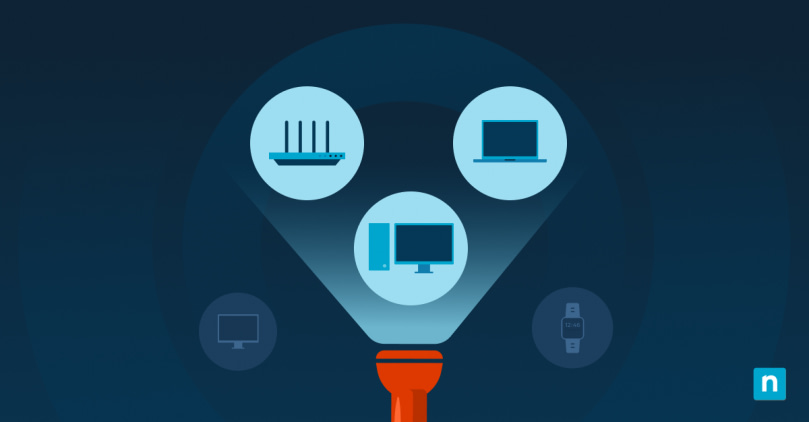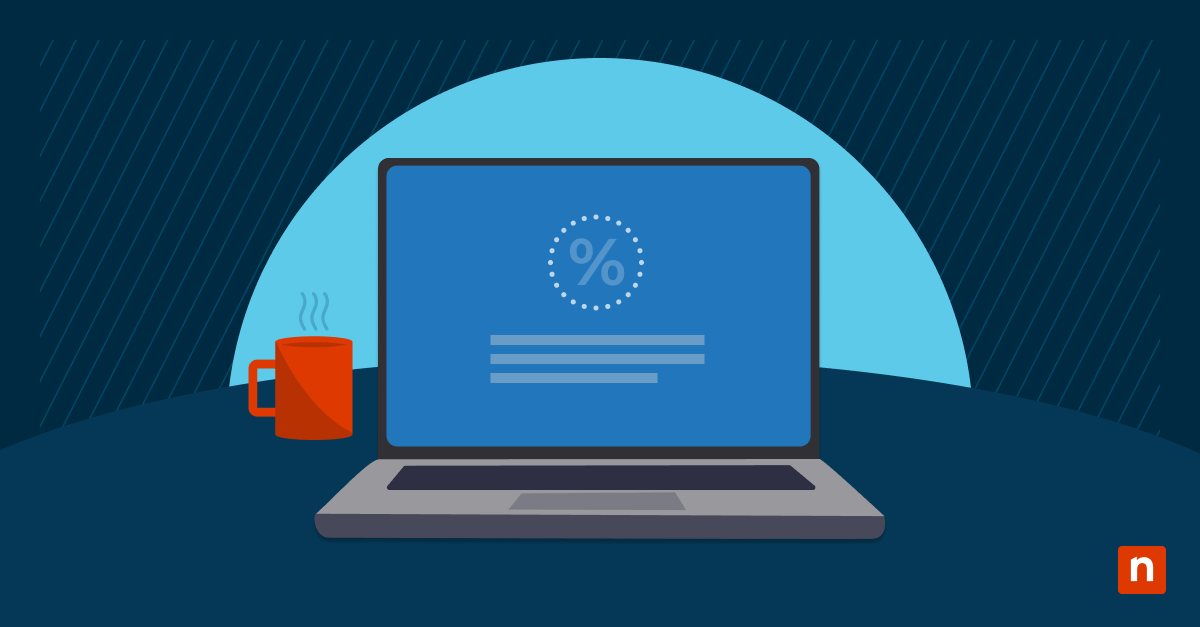By its nature, shadow IT is often unseen by IT security teams. This oversight routinely risks organizations violating data privacy laws, distorting IT budgets, and being exposed to nefarious actors. In a remote work environment, shadow IT poses a new threat that must be actively managed.
→ Download your free Shadow IT Report [PDF]
What is shadow IT?
Shadow IT is the practice of using information technology systems that an organization’s IT department does not manage. This can be anything from using an unsanctioned personal device to downloading software or applications that the IT department does not approve.
Understanding shadow IT behaviors
The rise of unconventional work setups that have become normalized in recent years has created many challenges for businesses and organizations. One is ensuring the company’s data is protected from breaches and unauthorized access. Providing sanctioned devices can establish a baseline level of control. However, some hurdles still exacerbate the risks associated with shadow IT. These hurdles encompass IT behaviors displayed by employees themselves that contribute to the risks brought by shadow IT.
Examples of shadow IT practices
To give you a better overview of shadow IT, here are some common shadow IT examples:
- Downloading unapproved software. While it may seem harmless to download and install software and applications from an official software distributor, this doesn’t mean that it’s completely secure. Some software will ask users to grant permission to access sensitive data, system resources, network connections, etc. One wrong click granting these permissions can lead to data breaches, compliance violations, or even malware infections.
- Sharing login credentials. Another practice with a clear security breach risk is sharing login credentials. Usernames and passwords are not supposed to be shared with anyone else. Doing this can easily compromise the security of the user’s accounts and open the door to potential misuse.
- Using personal devices for work. More and more companies have started providing employees with devices they should use exclusively for work. However, some employees still use their personal devices despite the potential security risks. This poses a risk of exposing company data to malware or compromising personal data through work applications.
- Using unauthorized cloud storage services. Employees get tempted to use cloud storage services that they can easily access. This cloud storage that the company does not authorize poses a significant security risk. They may even cause loss of critical company data, leading to operational disruptions, reputational damage, and significant financial penalties.
- Utilizing unauthorized communication tools. Sharing confidential information through communication tools not approved by your organization may cause serious breaches of security protocols and compromise sensitive data.
The negative implications of shadow IT usage
Since we’ve uncovered motivations for shadow IT adoption, it’s crucial to investigate the dangers it may cause an organization. As we’ve mentioned, shadow IT practices pose risks of information breach and data loss. This is why a recent study by Entrust revealed that 77% of IT professionals are concerned about shadow IT becoming a significant issue in 2023. It’s an inevitable consequence of the emergence of remote work and hybrid employment setup.
Shadow IT can also expose IT infrastructures to apparent vulnerabilities. Software and devices that are not authorized typically lack security patches and updates implemented by companies. This might create entry points for malware and cyberattacks, potentially compromising the entire network which can lead to widespread disruptions, data, and financial losses.
The pros and cons of shadow IT usage
It’s easy to avoid shadow IT practices if they only have negative consequences. However, shadow IT can offer some user-end benefits alongside its significant risks.
Pros:
- Employee satisfaction. Utilizing unauthorized tools that may aid in expediting workflow can ease an employee’s burdens.
- Increased productivity. If a user is satisfied with the unsanctioned IT system they’re using, it can potentially lead to increased efficiency and productivity gains.
- Innovation introduction. Using unapproved IT systems may lead to the discovery of more innovative tools and efficient ways of completing tasks.
- Flexibility and adaptability. Shadow IT allows users to utilize tools they are familiar with and comfortable using. This reduces a steep learning curve and can increase efficiency.
- Collaboration. Shadow IT practices involving unauthorized communication channels may promote a more efficient collaboration among users.
- Personalization. Shadow IT tools may offer more personalization than standardized, one-size-fits-all solutions provided by the IT department.
Cons:
- Exposure to vulnerabilities. Shadow IT tools are easy targets for cyberattacks because they often lack security features and protocols implemented by an organization’s IT team.
- Non-compliance with regulations. Most organizations comply with industry regulations or data privacy laws. Shadow IT tools also frequently lack the essential safeguards to ensure compliance, putting the organization at significant risk.
- Support hurdles. Sanctioned IT systems are in place to resolve any issues that may arise immediately. Shadow IT tools may not have complete dedicated support infrastructure, which can prevent technical issues from being resolved.
- Data loss. Shadow IT tools increase the risk of sensitive data loss due to the lack of data protection measures often found in unauthorized tools.
- Financial losses. Data breaches caused by the use of shadow IT tools can lead to revenue loss. This can be due to several factors, such as regulatory fines, incident response costs, operational downtime, etc.
- Version control issues. Multiple versions of unauthorized software used across the organization can create compatibility problems and hinder collaboration.
What we do in the shadows: The dangers of hidden IT behavior
To better understand the shadow IT behaviors of employees working remotely due to COVID-19, NinjaOne surveyed 400 remote workers in the UK across multiple industries. We learned that while most respondents were aware of their organization’s security policies, employees will often skirt the rules, using an array of physical devices like hard drives and smartphones and digital tools like communication and business software.
Recommendations based on the survey results suggest frequent security training combined with clear policies and frictionless IT experiences can reduce or eliminate some of the reasons employees turn to shadow devices and applications in the first place.
In the remote work era, full management of devices interacting with company data should be in place. It’s the job of leadership to understand the needs and obstacles of their team and set the tone and policies regarding basic security hygiene.
To learn more about how shadow IT is impacting the organization and how to turn these security gaps into opportunities, download our full Shadow IT Report.
Download your shadow IT report
to learn more about the dangers of hidden IT behavior ☠️
How to identify shadow IT within your own organization
Determining shadow IT is essential in protecting your organization’s data, assets, and entire IT infrastructure. There are several ways to execute this:
- Monitoring network traffic and logs. Unusual network activities can be a sign of shadow IT activity, which can be identified by extensive network traffic and system log monitoring. IT admins can monitor network traffic and review logs from firewalls and proxies to identify unusual traffic patterns or connections to external services that aren’t part of your approved IT stack.
- Utilizing security monitoring solutions. You can deploy several tools to help identify shadow IT within your organization. Here are some you can utilize:
- CASB – A Cloud Access Security Broker is a set of security tools that act as intermediaries between your organization and cloud service providers. It can monitor cloud app usage, which helps significantly in identifying IT shadow monitoring and discovery.
- EDR – Endpoint Detection and Response is a solution that monitors and secures individual endpoints within a network. In shadow IT detection, EDR tools can identify unauthorized or unapproved software or applications on an endpoint.
- MDM – Mobile Device Management solution is a tool specifically developed for monitoring and managing mobile devices. MDM tools are helpful for organizations that want to manage mobile devices that they either distribute to their employees (company-owned) or authorize a BYOD (Bring Your Own Device) policy. IT admins can leverage MDM tools to monitor applications installed on managed mobile devices. These tools can also help track and manage mobile devices to ensure compliance with corporate policies.Organizations can use these solutions to enhance the visibility of shadow IT activities across various platforms and devices.
- Conducting software and device audits. There are practices IT admins can regularly follow to identify shadow IT activities. One of them is performing software audits using tools like SAM or Software Asset Management that can track installed software to highlight unapproved ones. Meanwhile, Active Directory (AD) auditing allows IT admins to monitor user permissions, catching unauthorized installations linked to elevated access.
- Setting clear policies. Establishing clear IT policies should organize, streamline, and outline software requests and usage within an organization. Enforce management policies in software and device utilization by regularly reviewing software usage and restricting administrative privileges for software installations. This helps prevent shadow IT while ensuring compliance with security and regulatory standards.
- Engaging with employees. Knowing the underlying reasons why employees practice shadow IT can mitigate the risks associated with their actions. Organizations can conduct surveys or solicit employee feedback to understand why they use unapproved software or devices. This is also a way to identify your employees’ needs and address gaps in your software offerings, reducing the reliance on shadow IT. Educating employees is another way to impart knowledge about the dangers of shadow IT practices. These initiatives can help eliminate IT shadow practices within an organization.
What are common causes for the rise of shadow IT practices within an organization?
Engaging with employees can unmask different reasons why they turn to shadow IT practices. Here are some of them:
- Lack of suitable tools. Companies may allow the use of tools that are not well-suited for their employees’ particular needs. This causes employees to resort to using unauthorized tools, such as software that has all the features they need to complete their tasks effectively or devices that offer more extensive functionalities compared to what their employers authorized them to use.
- Desire for increased productivity. Employees may want to get their work done quickly and efficiently. However, suppose approved tools may prevent them from doing their tasks at their accustomed pace. In that case, they may be driven to utilize alternative tools to maximize productivity.
- Slow approval process. Your tools may be efficient in getting your employees’ jobs done. However, if lengthy setup and approval processes get in the way, employees may turn to shadow IT practices, bypassing the formal process of requesting software or devices to be authorized for usage.
- Lack of awareness. There are also instances when employees might not realize they are already engaging in shadow IT activities. Some employees may install software or services for utilization alongside approved tools, thinking there will be no drawbacks.
- Remote or flexible work environments. As remote work becomes more common, employees often have more autonomy over the tools they use. In an effort to adapt to their work environment, they may use personal devices or software that hasn’t been vetted by IT, further increasing shadow IT risks.
What should you do after identifying shadow IT within your company?
Doing the next steps properly after identifying shadow IT within your organization is critical. Here are some essential ways to alleviate the issue:
Conduct a risk assessment.
This involves evaluating the issues shadow IT practices may have caused and their extent and potential impact. Knowing these factors can help you understand the severity and reach of shadow IT activities within your organization. Conducting a risk assessment can also aid in forming a solid plan on what steps to take afterward to mitigate the issue and prevent it from happening again.
Understand employee needs.
As mentioned, you can conduct surveys and solicit employee feedback to understand their needs. The answers you will get will help Identify why employees are resorting to shadow IT. Employees’ feedback may also help in assessing their needs and motivations. This improves the alignment of your approved solutions with the employees’ requirements to maximize productivity and get their work done efficiently.
Implement training and policy communication.
While catering to your employees’ needs is essential, enforcing policies your management has agreed upon is also vital. To help employees cope with your policies, you can educate them on how you end up choosing the devices or software you approved. Training that explains the risks of shadow IT and the importance of adhering to approved systems is also a viable undertaking. Ensure existing policies on shadow IT are clearly communicated and enforced.
Managing shadow IT behavior
With the emergence of hybrid and remote work setups, some employees find IT shadow tools beneficial. However, the benefits of these unauthorized IT systems are frequently short-term. While it can be challenging for organizations to fully eradicate shadow IT practices, there are ways to manage and mitigate risks. An endpoint management system like NinjaOne can be a perfect ally in this endeavor.
NinjaOne empowers IT teams to manage and mitigate shadow IT behavior. Its features grant real-time visibility over your network, automate tasks, and enforce security policies while providing user-friendly access to approved IT solutions. This ultimately boosts security and employee satisfaction, fostering a secure and productive work environment that empowers employees while safeguarding critical data and assets.
FAQs
- How to communicate IT policies to prevent shadow IT?
There are many ways to communicate IT policies to employees to prevent shadow IT practices. One is by using real-world examples to explain why IT policies are enforced and why organizations are eliminating shadow IT practices. These examples can also include the consequences of shadow IT. - What are the common consequences of shadow IT?
Some of the most common consequences of shadow IT are data breaches, insecure IT infrastructure, revenue loss, legal implications, reputational damages, and more. - What are the best practices for shadow IT monitoring?
Best practices include continuous network monitoring for unauthorized devices or applications, implementing strict access controls, and using automated tools to detect and block unapproved software. Leverage an effective monitoring and management solution that can help admins identify if shadow IT is happening within the organization. - How to measure the impact of shadow IT management?
The impact of shadow IT management can be measured by tracking reductions in unauthorized software usage, improved network performance, and fewer security incidents. Surveys and feedback from employees can also provide insight into the effectiveness of policies. - What are the emerging trends in shadow IT management?
Emerging trends include more robust monitoring and management tools that help detect shadow IT more efficiently. There is also an increased focus on monitoring cloud applications and the rise of Zero-trust architecture, ensuring network security.








